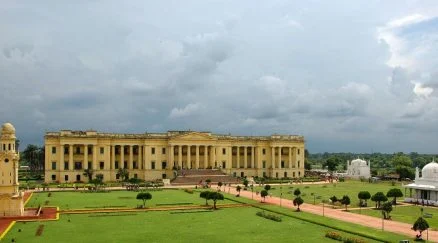1. Introduction
 |
| Nizamat Imambara |
Murshidabad, a city nestled on the banks of the Bhagirathi River in West Bengal, holds a significant place in India’s historical and political narrative. Once a flourishing capital under the Nawabs of Bengal, it became a strategic and cultural hub during the 18th century. This article explores the historical journey of Murshidabad, its political importance, and its lasting legacy.
Table of Contents
1. Introduction
2. Origins and Rise of Murshidabad
3. Murshid Quli Khan and Establishment as Capital
4. Political Significance under the Nawabs of Bengal
5. Murshidabad’s Role in Colonial Politics
6. Economic and Cultural Flourishing
7. Decline and Shift of Capital
8. Legacy and Heritage Today
9. Tourist Attractions in Murshidabad
......10. Conclusion
2. Origins and Rise of Murshidabad
Murshidabad’s rise to prominence began in the early 18th century during the waning influence of the Mughal Empire. Before its elevation as a capital, the region was a part of the larger Bengal Subah, with Dhaka as the seat of administration. The shift from Dhaka to Murshidabad was not just geographic but strategic, influenced by economic opportunities, trade routes, and political aspirations.
3. Murshid Quli Khan and Establishment as Capital
The city derives its name from Murshid Quli Khan, the first Nawab of Bengal under the Mughals. Appointed as the Diwan (finance minister) of Bengal in 1701 by Emperor Aurangzeb, Murshid Quli Khan moved the capital from Dhaka to Murshidabad around 1717. The move was driven by his desire to centralize power and manage Bengal’s booming economy more effectively.
Murshid Quli Khan developed the city with administrative buildings, palaces, mosques, and marketplaces, transforming it into a political nucleus. By renaming the city after himself, he left an indelible mark on Bengal's history.
4. Political Significance under the Nawabs of Bengal
Murshidabad emerged as the power center of Bengal, Bihar, and Orissa, collectively known as the Subah of Bengal. The Nawabs ruled semi-autonomously under nominal Mughal authority. The city was a hub of administration, where major decisions concerning revenue, law, and military affairs were taken.
Under Nawabs like Alivardi Khan and Siraj-ud-Daulah, Murshidabad reached the zenith of its power. The city was not only the seat of governance but also a place of political intrigue and strategic negotiations with European trading companies, including the British East India Company.
5. Murshidabad’s Role in Colonial Politics
Murshidabad played a central role during the pivotal events leading to British colonial domination in India. The Battle of Plassey in 1757, fought near the city, was a turning point. Siraj-ud-Daulah, the last independent Nawab of Bengal, was betrayed by Mir Jafar, leading to a British victory and the beginning of British political supremacy in India.
After the battle, although the British installed puppet nawabs, the real administrative power shifted to Calcutta (Kolkata), diminishing Murshidabad’s political influence.
6. Economic and Cultural Flourishing
In the 18th century, Murshidabad was one of the richest cities in India, renowned for its silk and textile industry. The city attracted merchants, artisans, and traders from across Asia and Europe. The Murshidabad silk, in particular, was highly prized and exported globally.
The city also became a cultural beacon, patronizing art, music, literature, and architecture. Persian and Bengali languages flourished, and intricate Mughal-style architecture gave the city a majestic charm.
7. Decline and Shift of Capital
Despite its grandeur, Murshidabad’s decline began after the British took control. The capital of Bengal was officially shifted to Calcutta in 1772, reducing Murshidabad to a symbolic seat of the Nawab. The British slowly dismantled the political structure, restricted the Nawabs’ powers, and redirected economic activities toward Calcutta.
Over time, the city’s political relevance waned, and it became a relic of the past, though its architectural heritage endured.
Murshidabad today stands as a testament to its glorious past. Its palaces, gardens, and tombs echo tales of grandeur, diplomacy, betrayal, and transformation. The city serves as a historical case study of the transition from Mughal autonomy to British colonialism.
It’s a critical location for students, historians, and travelers interested in understanding the socio-political evolution of eastern India.
9. Tourist Attractions in Murshidabad
Several historical monuments in Murshidabad offer a glimpse into its rich past:
## Hazarduari Palace: Built in 1837 by Duncan MacLeod for Nawab Humayun Jah, the palace has 1000 doors and is now a museum showcasing Nawabi artifacts.
## Katra Mosque: Constructed by Murshid Quli Khan, it serves as his tomb and reflects Indo-Islamic architectural brilliance.
## Nizamat Imambara: One of the largest Imambaras in India, it lies opposite the Hazarduari Palace.
## Motijhil: A horseshoe-shaped lake surrounded by colonial and Nawabi structures, representing the city’s hybrid history.
## Jahan Kosha Cannon: A massive cannon from the Mughal period that symbolizes Murshidabad’s military history.
These sites make Murshidabad a living museum and a top heritage destination in Bengal.
10. Conclusion
Murshidabad’s transformation from a provincial town to a powerful capital and then into a symbolic seat of Nawabi heritage reflects the complex tapestry of Indian history. It played a vital role in shaping the political destiny of Bengal and, by extension, the Indian subcontinent.
Understanding Murshidabad’s historical and political significance helps us appreciate the interplay of power, culture, and colonial ambition that defined the region. For historians, students, and heritage lovers, Murshidabad remains a window into India’s imperial and colonial past.







No comments:
Post a Comment